Chengbin Quan
LLaMA-Excitor: General Instruction Tuning via Indirect Feature Interaction
Apr 01, 2024Abstract:Existing methods to fine-tune LLMs, like Adapter, Prefix-tuning, and LoRA, which introduce extra modules or additional input sequences to inject new skills or knowledge, may compromise the innate abilities of LLMs. In this paper, we propose LLaMA-Excitor, a lightweight method that stimulates the LLMs' potential to better follow instructions by gradually paying more attention to worthwhile information. Specifically, the LLaMA-Excitor does not directly change the intermediate hidden state during the self-attention calculation of the transformer structure. We designed the Excitor block as a bypass module for the similarity score computation in LLMs' self-attention to reconstruct keys and change the importance of values by learnable prompts. LLaMA-Excitor ensures a self-adaptive allocation of additional attention to input instructions, thus effectively preserving LLMs' pre-trained knowledge when fine-tuning LLMs on low-quality instruction-following datasets. Furthermore, we unify the modeling of multi-modal tuning and language-only tuning, extending LLaMA-Excitor to a powerful visual instruction follower without the need for complex multi-modal alignment. Our proposed approach is evaluated in language-only and multi-modal tuning experimental scenarios. Notably, LLaMA-Excitor is the only method that maintains basic capabilities while achieving a significant improvement (+6%) on the MMLU benchmark. In the visual instruction tuning, we achieve a new state-of-the-art image captioning performance of 157.5 CIDEr on MSCOCO, and a comparable performance (88.39%) on ScienceQA to cutting-edge models with more parameters and extensive vision-language pertaining.
Teeth-SEG: An Efficient Instance Segmentation Framework for Orthodontic Treatment based on Anthropic Prior Knowledge
Apr 01, 2024



Abstract:Teeth localization, segmentation, and labeling in 2D images have great potential in modern dentistry to enhance dental diagnostics, treatment planning, and population-based studies on oral health. However, general instance segmentation frameworks are incompetent due to 1) the subtle differences between some teeth' shapes (e.g., maxillary first premolar and second premolar), 2) the teeth's position and shape variation across subjects, and 3) the presence of abnormalities in the dentition (e.g., caries and edentulism). To address these problems, we propose a ViT-based framework named TeethSEG, which consists of stacked Multi-Scale Aggregation (MSA) blocks and an Anthropic Prior Knowledge (APK) layer. Specifically, to compose the two modules, we design 1) a unique permutation-based upscaler to ensure high efficiency while establishing clear segmentation boundaries with 2) multi-head self/cross-gating layers to emphasize particular semantics meanwhile maintaining the divergence between token embeddings. Besides, we collect 3) the first open-sourced intraoral image dataset IO150K, which comprises over 150k intraoral photos, and all photos are annotated by orthodontists using a human-machine hybrid algorithm. Experiments on IO150K demonstrate that our TeethSEG outperforms the state-of-the-art segmentation models on dental image segmentation.
VideoDistill: Language-aware Vision Distillation for Video Question Answering
Apr 01, 2024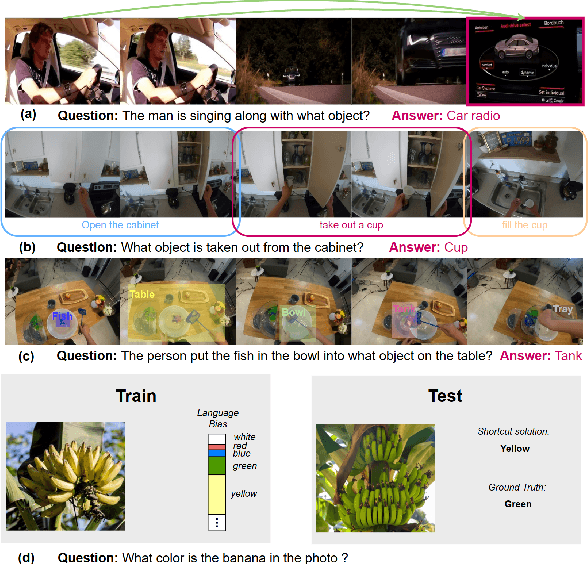

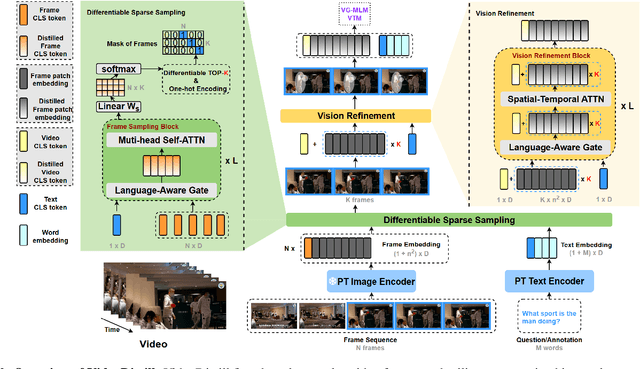
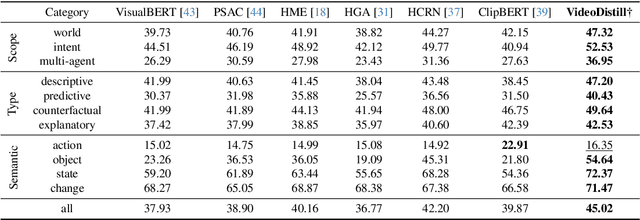
Abstract:Significant advancements in video question answering (VideoQA) have been made thanks to thriving large image-language pretraining frameworks. Although these image-language models can efficiently represent both video and language branches, they typically employ a goal-free vision perception process and do not interact vision with language well during the answer generation, thus omitting crucial visual cues. In this paper, we are inspired by the human recognition and learning pattern and propose VideoDistill, a framework with language-aware (i.e., goal-driven) behavior in both vision perception and answer generation process. VideoDistill generates answers only from question-related visual embeddings and follows a thinking-observing-answering approach that closely resembles human behavior, distinguishing it from previous research. Specifically, we develop a language-aware gating mechanism to replace the standard cross-attention, avoiding language's direct fusion into visual representations. We incorporate this mechanism into two key components of the entire framework. The first component is a differentiable sparse sampling module, which selects frames containing the necessary dynamics and semantics relevant to the questions. The second component is a vision refinement module that merges existing spatial-temporal attention layers to ensure the extraction of multi-grained visual semantics associated with the questions. We conduct experimental evaluations on various challenging video question-answering benchmarks, and VideoDistill achieves state-of-the-art performance in both general and long-form VideoQA datasets. In Addition, we verify that VideoDistill can effectively alleviate the utilization of language shortcut solutions in the EgoTaskQA dataset.
Building an Invisible Shield for Your Portrait against Deepfakes
May 22, 2023Abstract:The issue of detecting deepfakes has garnered significant attention in the research community, with the goal of identifying facial manipulations for abuse prevention. Although recent studies have focused on developing generalized models that can detect various types of deepfakes, their performance is not always be reliable and stable, which poses limitations in real-world applications. Instead of learning a forgery detector, in this paper, we propose a novel framework - Integrity Encryptor, aiming to protect portraits in a proactive strategy. Our methodology involves covertly encoding messages that are closely associated with key facial attributes into authentic images prior to their public release. Unlike authentic images, where the hidden messages can be extracted with precision, manipulating the facial attributes through deepfake techniques can disrupt the decoding process. Consequently, the modified facial attributes serve as a mean of detecting manipulated images through a comparison of the decoded messages. Our encryption approach is characterized by its brevity and efficiency, and the resulting method exhibits a good robustness against typical image processing traces, such as image degradation and noise. When compared to baselines that struggle to detect deepfakes in a black-box setting, our method utilizing conditional encryption showcases superior performance when presented with a range of different types of forgeries. In experiments conducted on our protected data, our approach outperforms existing state-of-the-art methods by a significant margin.
Delving into Sequential Patches for Deepfake Detection
Jul 06, 2022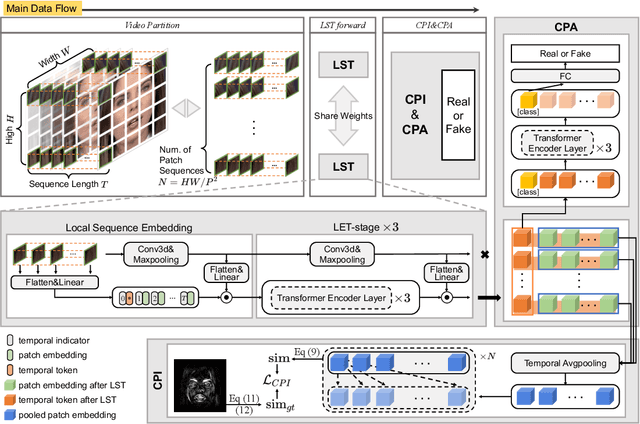
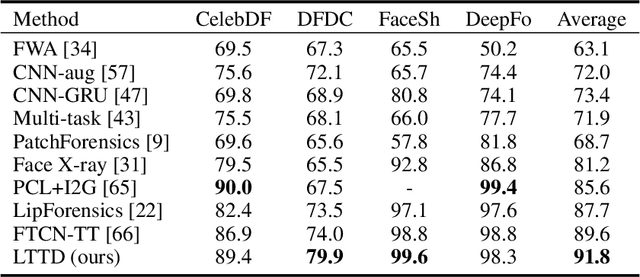
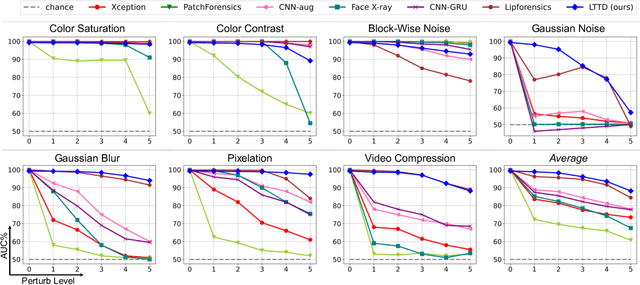

Abstract:Recent advances in face forgery techniques produce nearly visually untraceable deepfake videos, which could be leveraged with malicious intentions. As a result, researchers have been devoted to deepfake detection. Previous studies has identified the importance of local low-level cues and temporal information in pursuit to generalize well across deepfake methods, however, they still suffer from robustness problem against post-processings. In this work, we propose the Local- & Temporal-aware Transformer-based Deepfake Detection (LTTD) framework, which adopts a local-to-global learning protocol with a particular focus on the valuable temporal information within local sequences. Specifically, we propose a Local Sequence Transformer (LST), which models the temporal consistency on sequences of restricted spatial regions, where low-level information is hierarchically enhanced with shallow layers of learned 3D filters. Based on the local temporal embeddings, we then achieve the final classification in a global contrastive way. Extensive experiments on popular datasets validate that our approach effectively spots local forgery cues and achieves state-of-the-art performance.
CORE: Consistent Representation Learning for Face Forgery Detection
Jun 06, 2022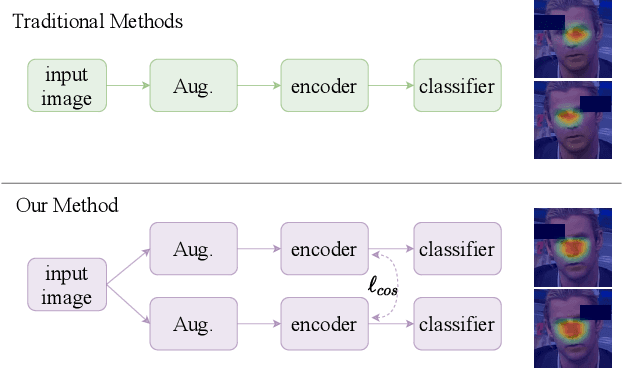

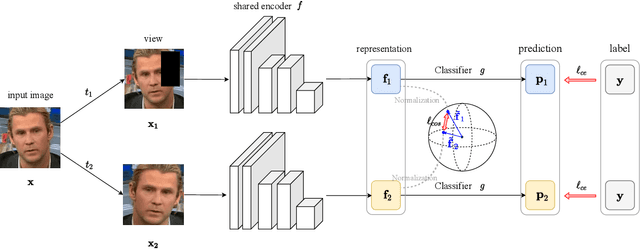
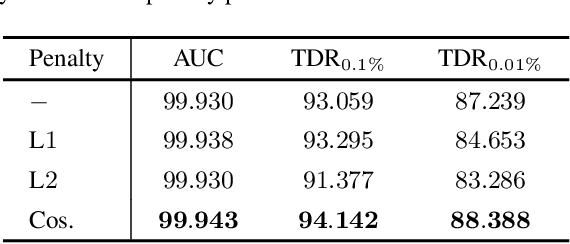
Abstract:Face manipulation techniques develop rapidly and arouse widespread public concerns. Despite that vanilla convolutional neural networks achieve acceptable performance, they suffer from the overfitting issue. To relieve this issue, there is a trend to introduce some erasing-based augmentations. We find that these methods indeed attempt to implicitly induce more consistent representations for different augmentations via assigning the same label for different augmented images. However, due to the lack of explicit regularization, the consistency between different representations is less satisfactory. Therefore, we constrain the consistency of different representations explicitly and propose a simple yet effective framework, COnsistent REpresentation Learning (CORE). Specifically, we first capture the different representations with different augmentations, then regularize the cosine distance of the representations to enhance the consistency. Extensive experiments (in-dataset and cross-dataset) demonstrate that CORE performs favorably against state-of-the-art face forgery detection methods.
 Add to Chrome
Add to Chrome Add to Firefox
Add to Firefox Add to Edge
Add to Edge